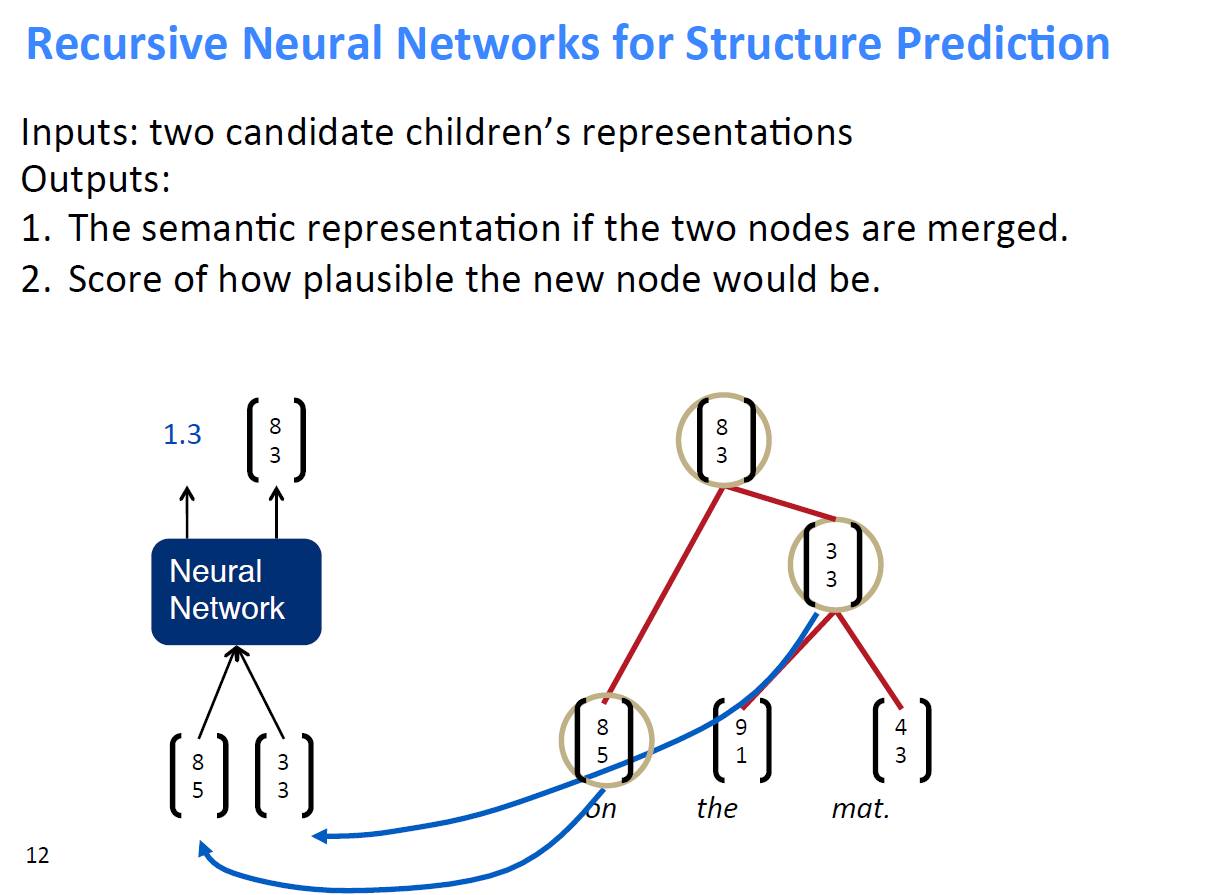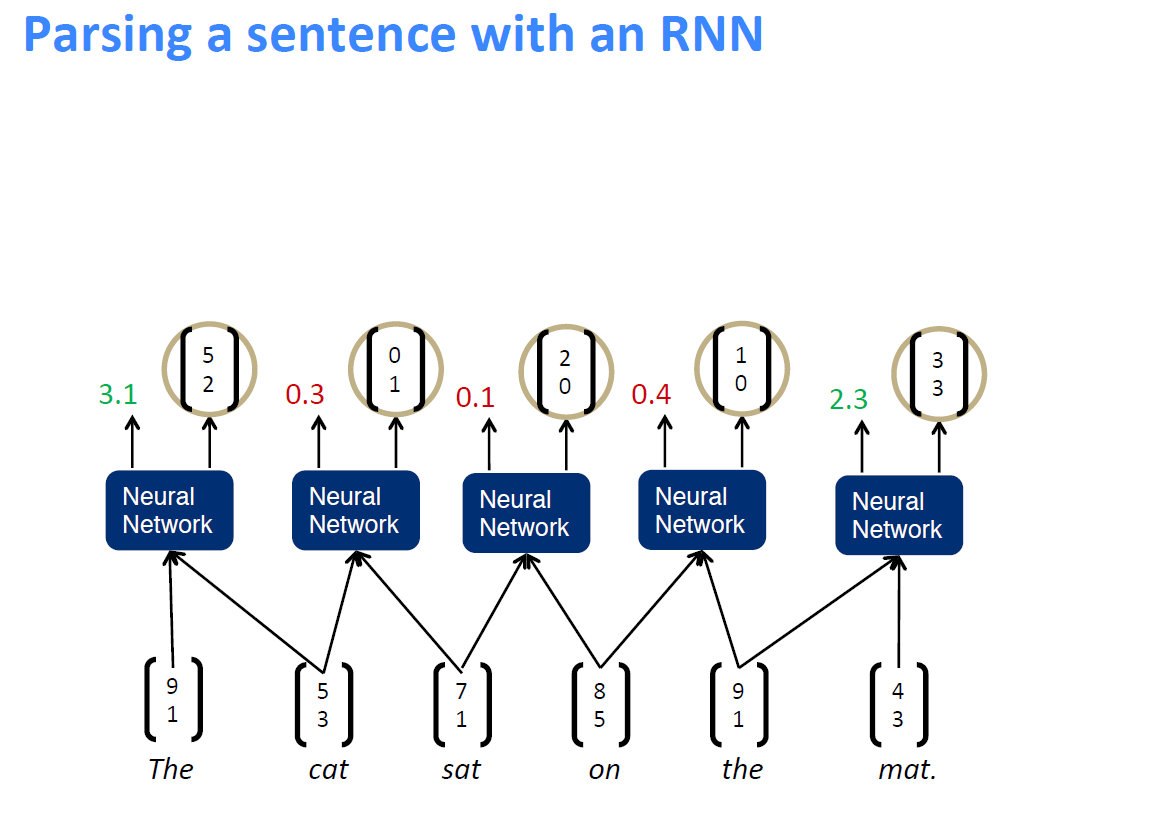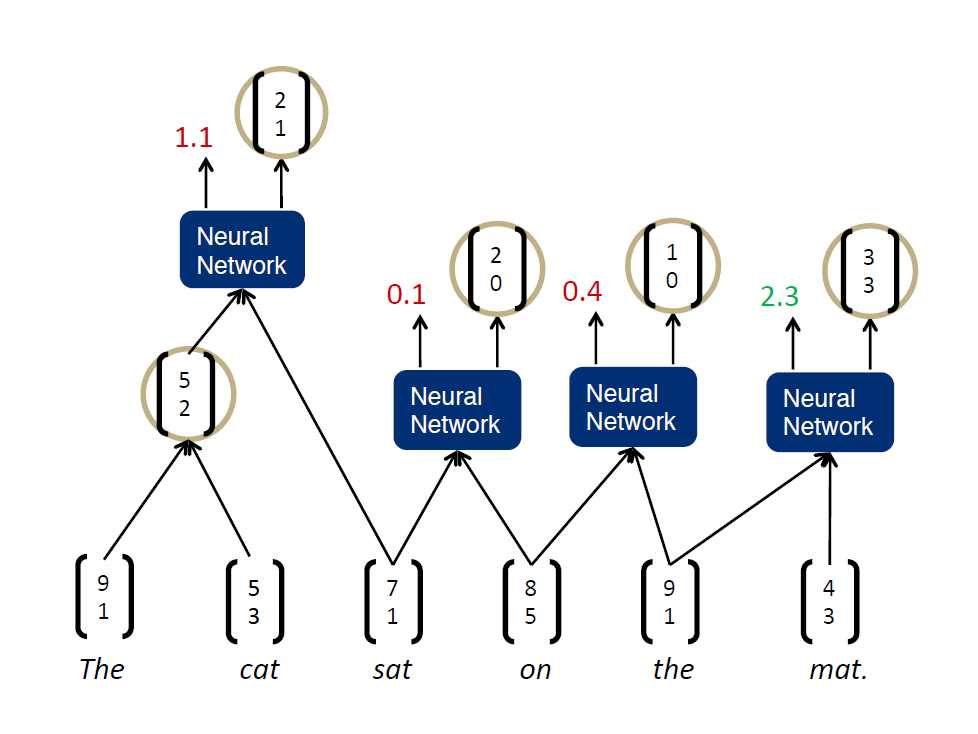cs224d 作业 problem set3 (一) 实现Recursive Nerual Net Work 递归神经网络
2024-09-06 01:16:04
1、Recursive Nerual Networks能够更好地体现每个词与词之间语法上的联系
这里我们选取的损失函数仍然是交叉熵函数

2、整个网络的结构如下图所示:



每个参数的更新时的梯队值如何计算,稍后再给大家计算相应的数学公式
这里先列出节点的合并规则




1、即假设将一句话中的词先两个合并,并通过神经网络计算出合并后的得分情况
2、然后找出合并后得分最高的两个词进行真正的合并,得到新的节点,其余节点不合并
3、将得到的新节点加入到下一轮两两合并的计算过程中,直至得到最终节点
下面是计算的代码:
'''
Created on 2017年10月5日 @author: weizhen
'''
# 一个简单的递归神经网络的实现,有着一个ReLU层和一个softmax层
# TODO : 必须要更新前向和后向传递函数
# 你可以通过执行 python rnn.py 方法来执行一个梯度检验
# 插入pdb.set_trace() 在你不确定将会发生什么的地方 import numpy as np
import collections
import pdb
import tree as treeM
import pickle class RNN: def __init__(self, wvecDim, outputDim, numWords, mbSize=30, rho=1e-4):
self.wvecDim = wvecDim
self.outputDim = outputDim
self.numWords = numWords
self.mbSize = mbSize
self.defaultVec = lambda : np.zeros((wvecDim,))
self.rho = rho def initParams(self):
np.random.seed(12341) # Word vectors
self.L = 0.01 * np.random.randn(self.wvecDim, self.numWords) # Hidden layer parameters
self.W = 0.01 * np.random.randn(self.wvecDim, 2 * self.wvecDim)
self.b = np.zeros((self.wvecDim)) # Softmax weights
# note this is " U "in the notes and the handout...
# there is a reason for the change in notation
self.Ws = 0.01 * np.random.randn(self.outputDim, self.wvecDim)
self.bs = np.zeros((self.outputDim)) self.stack = [self.L, self.W, self.b, self.Ws, self.bs] # Gradients
self.dW = np.empty(self.W.shape)
self.db = np.empty((self.wvecDim))
self.dWs = np.empty(self.Ws.shape)
self.dbs = np.empty((self.outputDim)) def costAndGrad(self, mbdata, test=False):
"""
每一个datum在minibatch里边都是一个树
前向计算每一个树,反向传播到每一个树
返回值:
cost:
梯度:w.r.t W,Ws,b,bs
以上变量的梯度都是在稀疏形式存储的
或者是以测试状态下的
Returns:
cost,correctArray,guessArray,total
"""
cost = 0.0
correct = []
guess = []
total = 0.0 self.L, self.W, self.b, self.Ws, self.bs = self.stack
# 初始化所有梯度都是0
self.dW[:] = 0
self.db[:] = 0
self.dWs[:] = 0
self.dbs[:] = 0
self.dL = collections.defaultdict(self.defaultVec) # 在每一个batch中前向计算每一个tree
for tree in mbdata:
c, tot = self.forwardProp(tree.root, correct, guess)
cost += c
total += tot
if test:
return (1. / len(mbdata)) * cost, correct, guess, total # 在每一个batch上进行反向传播
for tree in mbdata:
self.backProp(tree.root) # 通过mb的大小来计算损失和梯度
scale = (1. / self.mbSize)
for v in self.dL.values():
v *= scale # 添加L2正则化项
cost += (self.rho / 2) * np.sum(self.W ** 2)
cost += (self.rho / 2) * np.sum(self.Ws ** 2) return scale * cost, [self.dL, scale * (self.dW + self.rho * self.W), scale * self.db, scale * (self.dWs + self.rho * self.Ws), scale * self.dbs] def forwardProp(self, node, correct=[], guess=[]):
"""损失应该是一个不断更新的变量,总损失是我们需要用在准确率报告里边的数据"""
cost = total = 0.0
# 下面实现递归神经网络前向传播的函数
# 你应该更新 node.probs, node.hActsl,node.fprop,and cost
# node :你当前节点是在语法树上的
# correct : 这是一个不断更新的标记真值的列表
# guess: 这是一个不断更新的猜测我们的模型会预测为哪一个结果的列表
# (我们会同时使用正确的和猜测的值来构造我们的混淆矩阵)
L = self.L
# 隐藏层的参数
W = self.W
b = self.b # Softmax 权重
Ws = self.Ws
bs = self.bs if node.isLeaf:
node.hActsl = L[:, node.word]
else:
if not node.left.fprop:
cost_left, total_left = self.forwardProp(node.left, correct, guess)
cost += cost_left
total += total_left
if not node.right.fprop:
cost_right, total_right = self.forwardProp(node.right, correct, guess)
cost += cost_right
total += total_right node.hActsl = W.dot(np.hstack((node.left.hActsl, node.right.hActsl))) + b
node.hActsl[node.hActsl < 0] = 0 x = Ws.dot(node.hActsl) + bs
x -= np.max(x)
node.probs = np.exp(x) / np.sum(np.exp(x)) correct += [node.label]
guess += [np.argmax(node.probs)] cost -= np.log(node.probs[node.label]) node.fprop = True return cost, total + 1 def backProp(self, node, error=None):
"""
实现递归神经网络的反向传播函数
应该更新 self.dWs, self.dbs, self.dW, self.db, and self.dL[node.word] 相关地
node:你在语法树种的当前节点
error:误差从之前一个迭代过程中传递进来的
"""
# 清空节点
node.fprop = False L = self.L
# 隐藏节点的参数
W = self.W
b = self.b # Softmax层的权重
Ws = self.Ws
bs = self.bs error_this = node.probs
error_this[node.label] -= 1.0
delta = Ws.T.dot(error_this) self.dWs += np.outer(error_this, node.hActsl)
self.dbs += error_this if error is not None:
delta += error delta[node.hActsl == 0] = 0 if node.isLeaf:
self.dL[node.word] += delta
else:
self.dW += np.outer(delta, np.hstack([node.left.hActsl, node.right.hActsl]))
self.db += delta delta = np.dot(self.W.T, delta)
self.backProp(node.left, delta[:self.wvecDim])
self.backProp(node.right, delta[self.wvecDim:]) def updateParams(self, scale, update, log=False):
"""
如下这样更新参数
p:=p-scale*update
如果log是真的,输出根节点的均方误差,并且更新根节点的值
"""
if log:
for P, dP in zip(self.stack[1:], update[1:]):
pRMS = np.sqrt(np.mean(P ** 2))
dpRMS = np.sqrt(np.mean((scale * dP) ** 2))
print("weight rms=%f -- update rms=%f" % (pRMS, dpRMS))
self.stack[1:] = [P + scale * dP for P, dP in zip(self.stack[1:], update[1:])] # 解决词典并且进行稀疏的更新
dL = update[0]
for j in dL.iterkeys():
self.L[:, j] += scale.dL[j] def toFile(self, fid):
pickle.dump(self.stack, fid) def fromFile(self, fid):
self.stack = pickle.load(fid) def check_grad(self, data, epsilon=1e-6):
cost, grad = self.costAndGrad(data) err1 = 0.0
count = 0.0
print("Checking dW...")
for W, dW in zip(self.stack[1:], grad[1:]):
W = W[..., None]
dW = dW[..., None]
for i in range(W.shape[0]):
for j in range(W.shape[1]):
W[i, j] += epsilon
costP, _ = self.costAndGrad(data)
W[i, j] -= epsilon
numGrad = (costP - cost) / epsilon
err = np.abs(dW[i, j] - numGrad)
err1 += err
count += 1
if 0.001 > err1 / count:
print("Grad Check Passed for dW")
else:
print("Grad Check Failed for dW:Sum of Error=%.9f" % (err1 / count)) # check dL separately since dict
dL = grad[0]
L = self.stack[0]
err2 = 0.0
count = 0.0
print("Checking dL...")
for j in dL.keys():
for i in range(L.shape[0]):
L[i, j] += epsilon
costP, _ = self.costAndGrad(data)
L[i, j] -= epsilon
numGrad = (costP - cost) / epsilon
err = np.abs(dL[j][i] - numGrad)
err2 += err
count += 1
if 0.001 > err2 / count:
print("Grad Check Passed for dL")
else:
print("Grad Check Failed for dL: Sum of Error = %.9f" % (err2 / count)) if __name__ == '__main__': train = treeM.loadTrees()
numW = len(treeM.loadWordMap()) wvecDim = 10
outputDim = 5 rnn = RNN(wvecDim, outputDim, numW, mbSize=4)
rnn.initParams() mbData = train[:4]
print("Numerical gradient check...")
rnn.check_grad(mbData)
下面部分是构造节点的python文件tree.py
在进行计算时需要先运行tree.py文件进行tree结构的生成,然后进行合并计算
import collections
import pickle
UNK = 'UNK'
# This file contains the dataset in a useful way. We populate a list of Trees to train/test our Neural Nets such that each Tree contains any number of Node objects. # The best way to get a feel for how these objects are used in the program is to drop pdb.set_trace() in a few places throughout the codebase
# to see how the trees are used.. look where loadtrees() is called etc.. class Node: # a node in the tree
def __init__(self,label,word=None):
self.label = label
self.word = word # NOT a word vector, but index into L.. i.e. wvec = L[:,node.word]
self.parent = None # reference to parent
self.left = None # reference to left child
self.right = None # reference to right child
self.isLeaf = False # true if I am a leaf (could have probably derived this from if I have a word)
self.fprop = False # true if we have finished performing fowardprop on this node (note, there are many ways to implement the recursion.. some might not require this flag)
self.hActs1 = None # h1 from the handout
self.hActs2 = None # h2 from the handout (only used for RNN2)
self.probs = None # yhat class Tree: def __init__(self,treeString,openChar='(',closeChar=')'):
tokens = []
self.open = '('
self.close = ')'
for toks in treeString.strip().split():
tokens += list(toks)
self.root = self.parse(tokens) def parse(self, tokens, parent=None):
assert tokens[0] == self.open, "Malformed tree"
assert tokens[-1] == self.close, "Malformed tree" split = 2 # position after open and label
countOpen = countClose = 0 if tokens[split] == self.open:
countOpen += 1
split += 1
# Find where left child and right child split
while countOpen != countClose:
if tokens[split] == self.open:
countOpen += 1
if tokens[split] == self.close:
countClose += 1
split += 1 # New node
node = Node(int(tokens[1])) # zero index labels node.parent = parent # leaf Node
if countOpen == 0:
node.word = ''.join(tokens[2:-1]).lower() # lower case?
node.isLeaf = True
return node node.left = self.parse(tokens[2:split],parent=node)
node.right = self.parse(tokens[split:-1],parent=node) return node def leftTraverse(root,nodeFn=None,args=None):
"""
Recursive function traverses tree
from left to right.
Calls nodeFn at each node
"""
nodeFn(root,args)
if root.left is not None:
leftTraverse(root.left,nodeFn,args)
if root.right is not None:
leftTraverse(root.right,nodeFn,args) def countWords(node,words):
if node.isLeaf:
words[node.word] += 1 def clearFprop(node,words):
node.fprop = False def mapWords(node,wordMap):
if node.isLeaf:
if node.word not in wordMap:
node.word = wordMap[UNK]
else:
node.word = wordMap[node.word] def loadWordMap():
with open('wordMap.bin','rb') as fid:
return pickle.load(fid) def buildWordMap():
"""
Builds map of all words in training set
to integer values.
""" file = 'trees/train.txt'
print("Reading trees to build word map..")
with open(file,'r') as fid:
trees = [Tree(l) for l in fid.readlines()] print("Counting words to give each word an index..") words = collections.defaultdict(int)
for tree in trees:
leftTraverse(tree.root,nodeFn=countWords,args=words) wordMap = dict(zip(words.keys(),range(len(words))))
wordMap[UNK] = len(words) # Add unknown as word print("Saving wordMap to wordMap.bin")
with open('wordMap.bin','wb') as fid:
pickle.dump(wordMap,fid) def loadTrees(dataSet='train'):
"""
Loads training trees. Maps leaf node words to word ids.
"""
wordMap = loadWordMap()
file = 'trees/%s.txt'%dataSet
print("Loading %sing trees.."%dataSet)
with open(file,'r') as fid:
trees = [Tree(l) for l in fid.readlines()]
for tree in trees:
leftTraverse(tree.root,nodeFn=mapWords,args=wordMap)
return trees if __name__=='__main__':
buildWordMap() train = loadTrees() print("Now you can do something with this list of trees!")
更详细的代码请参考github:
https://github.com/weizhenzhao/cs224d_problem_set3
最新文章
- JAVA 分页工具类及其使用
- ActiveMQ_Mqtt的TCP丢包
- C#双链表
- CSS中margin与padding的区别
- Java抽象类接口、内部类题库
- JavaScript中的3种弹出式消息提醒(警告窗口,确认窗口,信息输入窗口)的命令是什么?
- Jquery下拉效果
- cppunit使用详解
- HDU 5458 Stability (树链剖分+并查集+set)
- [ffmpeg 扩展第三方库编译系列] 关于需要用到cmake 创建 mingw32编译环境问题
- Jenkins 五: 构建Ant项目
- 在Ubuntu上下载、编译和安装Android最新源码
- Asp.Net WebApi+Microsoft.AspNet.WebApi.Core 启用CORS跨域访问
- JavaScript电话号码正则
- CSSOM视图模式
- jquery选择器从认识到使用初级篇
- web 之MVC
- 【if...else】三角形判断
- Bootstarp-table入门
- listview的gridview视图中,获取列中模板内的button按钮(找控件内的控件)